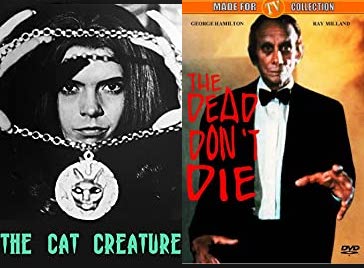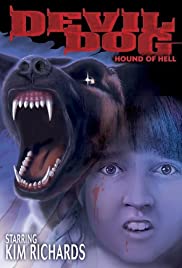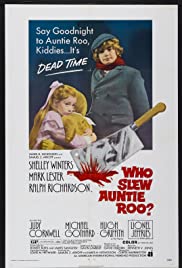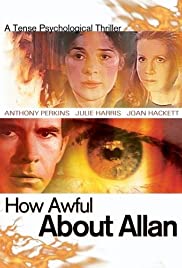Curtis Harrington was an interesting figure, towing the line between the avant garde and schlock cinema, reminiscent of forbearers like tVal Lewton and Jacques Tourneur who made minor masterpieces within the confines of horror and crime genres. After a stint as a film critic, Harrington began producing esoteric, surrealist short films and working with experimental filmmakers like Kenneth Anger and Maya Deren. His first feature film Night Tide is an eerie and haunting horror film about a mermaid with Dennis Hopper in his first starring role. Night Tide basically laid out the pattern Harrington would follow for much of his career, fusing tense atmosphere with less well-respected subject matter and touches of his avant garde roots to produce solid genre films under less than ideal circumstances (much of his career was plagued by very low budgets and producers cutting and tinkering with his films after post-production). After Night Tide, Harrington worked for Roger Corman, being given some footage from Russian sci-fi pictures and told to shoot new footage and fashion a narrative around them for American audiences. The results produced Voyage to the Prehistoric Planet and the surprisingly good Queen of Blood. Harrington would continue to work in the horror and thriller genres for much of his career in addition to quite a bit of TV work for shows like Dynasty and Charlie’s Angels (most likely to pay his bills). While Harrington would never have the massive success of some of his peers in the horror genre, he produced a string of consistently solid, well-paced, nicely atmospheric and at times surprisingly darkly witty films that are worth being rediscovered.

The Cat Creature (1973)
The Dead Don’t Die (1975)
The Cat Creature and The Dead Don’t Die were a pair of TV movies that Harrington directed based on Robert Bloch scripts and they feel like a conscious homage to Lewton’s and Tourneur’s Cat People and I Walked With A Zombie. The Cat Creature is the better of the two which basically plays out as a procedural mystery with an Egyptologist trying to discover who or what is causing a string of murders after the disappearance of a mummy at a museum as well as attempting to explain the mysterious presence of a cat seen at the scene of the crimes. It is pretty well-paced and in the spirit of The Cat People really doesn’t show much at all on-screen, relying more on shadows and sound to convey the suspense. It’s biggest failing is really its ending which comes across as pretty silly and a little anticlimactic. The Dead Don’t Die is an odd one. Resurrecting (heh) the Haitian voodoo zombie premise of I Walked With A Zombie and even setting the film in the 1930’s, it’s a noir pastiche about a detective trying to clear his dead brother’s name after he was executed for a murder he didn’t commit. The script is pretty ridiculous and I feel like casting George Hamilton as the lead was a misstep, making it hard to take seriously. Still, I think it’s worth a watch for fans of Harrington just for the unique premise alone.

Games (1967)
Games is a delightfully fun and twisty thriller about a pair of upper crust douche bags who get their kicks playing sadistic mind games with people. When an odd older woman shows up to their house one day purporting to have psychic abilities, they immediately jump on the opportunity to spin up some scenarios to play with. To go into any more detail would get into spoiler territory. Suffice it to say, if you enjoy constant twists in your story, some predictable and some less so, this will be right up your alley.

Devil Dog: Hound of Hell (1978)
Devil Dog: Hound of Hell is basically The Omen but with a dog. No, really. A family takes in a dog from a seemingly well-meaning trainer who is secretly a Satanist and has bred the dog as a conduit for a demon. Just like in The Omen, mysterious “accidents” start occurring around the dog leading the father of the family to become suspicious of its motives. The film isn’t terrible but has a fatal flaw at its core. The titular dog just isn’t threatening at all. The german shepherd in the lead role looks too cute and happy just sitting there panting while someone suffers a cruel fate at their paws. This is another late ’70s TV movie from Harrington and really suffers from the lo-fi format, making it appear flat, lifeless and uninspired. On a random side note, the kids in this movie were the same kids who played siblings in Escape to Witch Mountain which I watched not too long ago. Maybe it was a Buy 1, Get 1 Free kind of contract?

Ruby (1977)
Ruby is a solid effort from Harrington about a former gal pal of a notorious gangster who watches him swear vengeance before being executed. Jump forward 16 years later. She now runs a drive-in with a bunch of ex-gangsters and is suddenly plagued with a series of mysterious catastrophes. Is her weird mute daughter, who was born the night her gangster dad was executed, involved. While on the surface it seems like a ripoff of Carrie but with gangsters thrown in (it even has Piper Laurie in it) Ruby stands apart with its atmospheric pacing and some unique story aspects. Unfortunately it stumbles in the back half of the film when it should be sprinting but it still isn’t terrible.

Who Slew Auntie Roo? (1971)
Whoever Slew Auntie Roo? Is the first of a pair of questioning hagsploitation films that Harrington made with Shelley Winters (the other being being What’s the Matter with Helen?) and has a delightfully unhinged performance from Winters as an odd widower who invites children from an orphanage to spend Christmas with her (which is unsettling enough). But as the kids start to realize that she’s less a quirky but harmless rich lady and more a mentally ill and dangerous madwoman, their hopes of living to see next Christmas grows ever dimmer. This was a fun flick and definitely recommended for fans of crazy old lady movies.

The Killing Kind (1973)
The Killing Kind is one of the meaner-spirited Harrington films I’ve seen, about a young man recently released from prison after being forced into raping a girl and who has an unhealthy oedipal complex. One other theme I neglected to call out that’s common across many of Harrington’s films is the off-balance psyche. Mental derangement tends to play a major role, often a catalyst for the series of events in his films, and it’s certainly a major driver for this one. Your appreciation of The Killing Kind will depend on how well you can stomach this kind of unsavory subject matter. It definitely isn’t as extreme as films like Last House on the Left or I Spit on Your Grave, but compared to the rest of Harrington’s filmography, it may catch some folks unawares.

How Awful About Allan (1970)
How Awful About Allan is another of Harrington’s TV movies, this one featuring Anthony Perkins as Allan, a man recently released from a mental hospital after having a breakdown over the guilt of causing a house fire that killed his father and scarred his sister. When an odd new boarder shows up at his sister’s house where he stays, his paranoia grows, believing that someone is out to get him. This one is actually like Games in some ways and finds Harrington comfortably in mental illness territory. The actual production looks pretty cheap as one would expect of a TV movie, but it’s still fairly engaging with Perkins playing the kind of role he could do in his sleep.
Conclusion
I haven’t seen quite all of Harrington’s films yet (in particular The Killer Bees and Mata Hari) but having seen most of his filmography, I can safely say that Harrington was a true talent behind the camera who often found himself stymied by budgetary limitations but still frequently churned out clever, fun films full of atmosphere that are well worth checking out. One can only imagine what he would have made given a larger budget. As it is, he’s still made a couple of stone cold classics with Night Tide and Queen of Blood as well as a body of work to be proud of.

